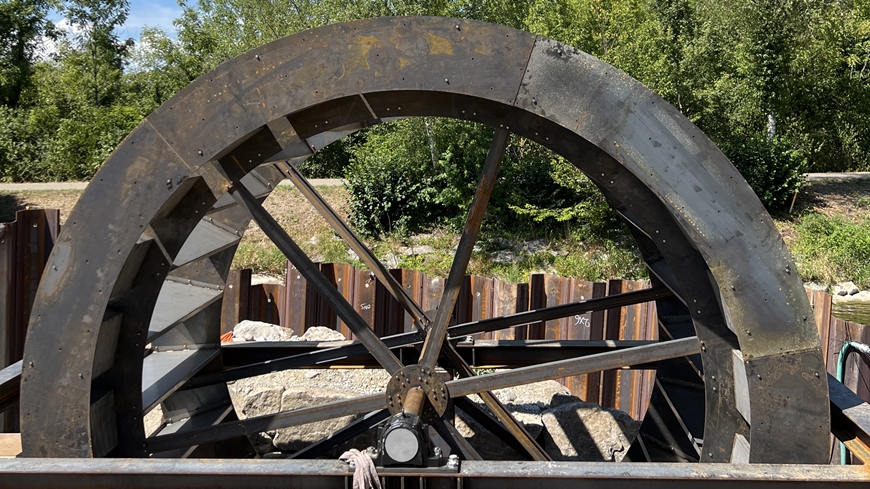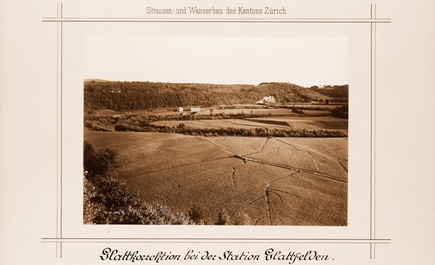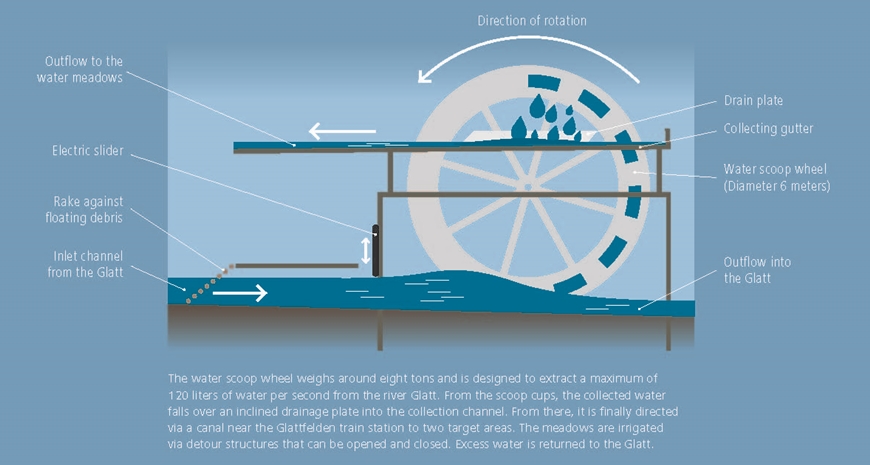Green technology
Steel wheel for biodiversity
Farmers once ensured rich harvests of hay by systematically irrigating meadows. In the canton of Zurich, environmentalists are bringing these methods back to life to create a valuable idyll with high biodiversity – using the historic technology of a water scoop wheel, which Empa-researchers helped to develop.

Dragonflies buzz through the sunny plain; blue butterflies and other colorful moths flutter from flower to flower. Midwife toads in search of females let out their call, while a grass snake looks for prey in the damp grass: a diverse biotope for endangered species that is to be created in the former floodplain called Hundig near Glattfelden in the Zurich lowlands -- thanks to an agricultural method that was common here long ago. Watering meadows probably originated in the Middle Ages and could more than double the hay harvest at the time. And to divert water from rivers and streams, farmers in German Franconia used nearly 200 water-scooping wheels around 1800.
This environmentally friendly technology is being revived here. "So it's an ecological and cultural-historical project," says project manager Daniela Eichenberger of the association "Wässerwiesen im Hundig". But this also required help from experts such as Silvain Michel from Empa's Mechanical Systems Engineering lab: He helped to implement the scoop wheel – based on a 1:5 model designed and built by metal construction entrepreneur Bernhard Krismer in Wallisellen. "The first tests with this scoop wheel showed that it would work in principle," Michel recalls.
But the work was only about to begin, because there were many question marks: How deep should the steel wheel, with a diameter of six meters after all, project into the Glatt? Would the water power of the shallow river at the planned location be sufficient to drive it? And to lift the necessary volume of water, which would then flow from the scoop cups into a channel leading to the meadows?
New measurement of river and bed

The initial research showed that the hydraulic data on the Glatt at this location were partially contradictory. Therefore, experts remeasured the river with its water levels at the planned location – and finally decided to change the thresholds of the river bottom. Above the scoop wheel, the threshold was raised by 30 centimeters, below it it was lowered by 30 centimeters. Two "steps", over which the Glatt flows towards the Rhine, were thus combined into one larger one – a gradient of almost one meter that could be used to increase the potential energy of the water for driving the wheel.
Nevertheless, initial analyses showed that hydropower could be in short supply; especially since the draw from the river is limited. The Glatt's prescribed residual flow of 1070 cubic meters per second must be maintained at all times – and withdrawal has been limited to a maximum of 120 liters per second. This is what preliminary tests had shown was needed in the meadows in 2019. At temperatures above 20 degrees, however, the quantity is gradually reduced – down to a quarter, depending on the discharge rate of the Glatt into the Rhine, which is recorded around the clock.
Ultimately, everyone wants to keep long-term climate protection in mind – as well as the interests of the local fishing club, which was concerned about the water level and its catch, including coveted trout, and objected to the building concession. "I have full understanding for this," says master metalworker Krismer, designer of the bailer, who is, after all, an angler himself. And project manager Daniela Eichenberger is also glad that a sensible solution could be found through successful negotiations. "Now it's time for implementation!" says the biologist, who has been in charge of the project since 2016.
Drive with pitfalls and tricks

Ensuring the reliable drive of the eight-ton scoop wheel under these conditions proved to be a real challenge for Empa researcher Silvain Michel. Initial calculations had assumed an efficiency of 90 percent – an extremely favorable ratio of energy supplied to energy used. But literature research showed that such an "undershot" water wheel, which is driven by water from below, usually achieves only up to 40 percent efficiency. "The maximum is 50 to 60 percent," Michel says, "so the original assumption was way too optimistic."
What to do? Michel sought advice from an expert: The experienced hydraulics expert and emeritus professor Michel Dubas from the Valais University of Applied Sciences in Sion made his knowledge and experience available – free of charge, by the way, as the Empa researcher points out. And after joint deliberations, Dubas proposed a simple but efficient solution: a goiter in the steel sole below the scoop wheel – in other words, a targeted downward bulge that ensures that the water accelerates significantly once again before it presses into the scoops of the wheel.
With this idea and other details, the hydraulics experts calculated, the pumping capacity of the wheel just about reaches the required values. And they are convinced that the performance is sufficient even despite some technical brakes on the water flow: After all, a rake in front of the wheel has to keep out floating material such as branches. Moreover, a curtain of steel chains in the water generates noise to ensure that fish stay in the Glatt and do not stray into the branch channel to the scoop wheel.
Two video cameras in the water will film whether this strategy actually works. And when the operation of the meadow watering system starts for the first time next year, not only the local fishermen will keep an eye on the scoop wheel, but also the Empa expert and the designers – to make sure water quantities are controlled reliably and the scoop wheel runs smoothly. After all, it is necessary to regularly look after things, check the rake and inflow gate valves, and also regularly lubricate the rotating axle of the steel wheel – the job for a water wheel keeper who is soon to be recruited.
A project with many helpers
The operation of the water meadows in Hundig with the scoop wheel and the supply line via canals is to start next year after a long planning and implementation phase. The wheel alone costs around 300,000 Swiss francs; the total for the entire project amounts to 2.4 million. Funding comes from Zurich Airport – as one of its ecological replacement measures, to which it is obliged – and from numerous sponsors, including the lottery fund of the Canton of Zurich and the electricity company of the City of Zurich EWZ, as well as numerous foundations. The project sponsors are the Wässerwiesen im Hundig association and the Nature Conservation Department of the Office for Landscape and Nature of the Canton of Zurich.
-
Share

|
Particulate matter |
|
The "oxidative potential" of particulate matter could serve as a criterion for assessing risks in the future – and Empa researchers have explored it for Switzerland. |
| Birth of a crystall |
|
Crystal structures can be created not only from atoms and ions, but also with superlattices - fascinating building blocks that are 100 times larger and have hardly any attraction to each other. |






